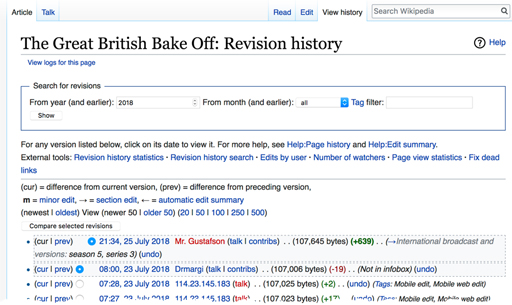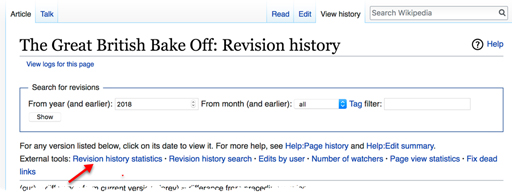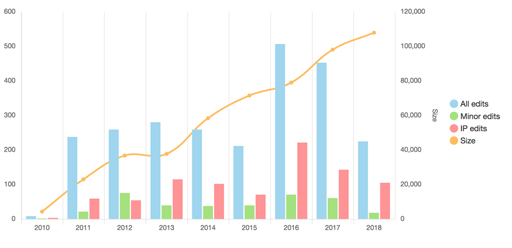3.1 Using Wikipedia
Wikipedia follows a quite different model from traditional encyclopedias. Instead of being a for-profit company, it is a non-profit charitable organisation [Tip: hold Ctrl and click a link to open it in a new tab. (Hide tip)] , funded by donations.
In traditional encyclopedias, an entry is either the work of a named individual or attributed to an editorial team. In contrast, Wikipedia content is ‘crowd-sourced’. The articles are the work of numerous unnamed volunteers. Each entry is usually the work of multiple authors, who are not individually credited. Anyone can register and start writing immediately.
This means that Wikipedia articles can be revised essentially in real-time. There is no approval process of the kind that applies to a traditional encyclopedia, where all changes are reviewed before they go live. Instead, Wikipedia relies on other volunteers to correct or clarify any inaccurate content.
This can make Wikipedia vulnerable to hoaxes, or to articles being edited to promote commercial interests or political agendas. This, and the fact that the authors are unidentified volunteers, has made many people cautious about how reliable Wikipedia is as an information source. However, many studies and comparisons have broadly supported the accuracy of Wikipedia, at least as a starting point for finding out about a topic.
Activity _unit3.3.2 Activity 7 Investigating Wikipedia page history
Since anyone can edit a Wikipedia article, there is an obvious risk of hoaxes, vandalism, promotion of particular interests or opinions and other misuse. To counteract this, Wikipedia keeps a complete record of every change that has been made to an article. This means that it is always possible to undo malicious changes. Also the full history of the article can be accessed, something that can be useful to researchers.
Find a Wikipedia article on any subject that you are interested in. At the top right there is a ‘View history’ tab (Figure 6).
Clicking on this will display a list of changes made to the page, by date and time (Figure 7). Of course, Wikipedia is always evolving, so if you revisit this page, it will look different.
The key at the top explains how to view a particular version. Other options let you see the statistics about the page, search the page history and access other information. The ‘Revision history statistics’ in particular are well worth looking at (Figure 8). They give you a good idea of just how many edits have been made to a Wikipedia article (Figure 9).
You may like to investigate a little more and look at some other page histories, but don't overdo it. It’s easy to get addicted!
In the next section you will meet a different way of searching for information using an engine that generates answers dynamically rather than just displaying existing information.




